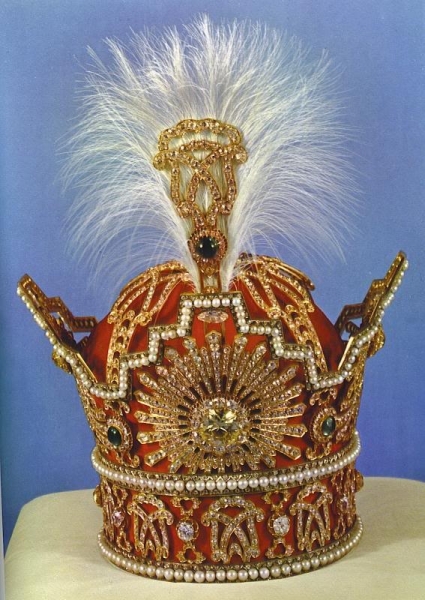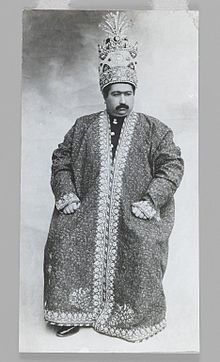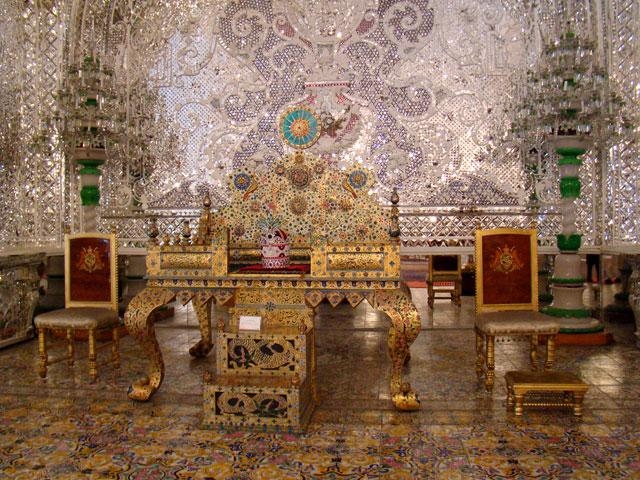Situated within the Central Bank of the Islamic Republic of Iran, since 1955, the Treasury of National Jewels (Iranian Crown Jewels) is held in a very secure vault. It is a collection of the most expensive jewels of the world, collected over centuries of turbulence, and is so unique it cannot be valued. We were not permitted to take photos or bags inside and had to go through several security checks….including one were I was not only pat searched but had my breasts felt up as well by an Iranian woman…..very strange – not sure what she thought I was hiding in there! Once all the checks were behind us we entered the lower level vault.
We saw the actual Takht-e Khurshīd (Sun/Peacock) Throne, that we had only previously seen a replica of in the Golstan Museum/Palace on our last trip to Tehran….it was magnificent and set aside in a separate area behind glass. The original was moved to the Treasury on 6th September 1981. It was made for Fath-Ali Shah Qajar and uses gold and loose stones from the Treasury. The sun at the top is encrusted with precious stones and gave it its name. After his marriage to Tavous Tajodoleh it changed to be called the Peacock Throne due to her being his favourite wife, called Lady Peacock.
Inside the vault we also saw his diamond, emerald and ruby set crown, the Kiani Crown. It is made of red velvet with 1800 small pearls (some only 7 mm in diameter) sewn on. The crown is 32 cm (12.5 in.) high and 19.5 cm (7.5 in.) wide. Traditionally the Kiani Crown was used for coronation of the Qajar Kings, but in 1925 Reza Khan Pahlavi had the Pahlavi Crown made using selected stones from the Treasury for his coronation on April 25, 1926 AD (although the Kiani Crown was still present). The Pahlavi Crown was also used in the coronation of Mahmmad Reza Pahlavi on October 26, 1967 AD. Made of gold and silver, and decorated with diamonds, emeralds, sapphires and pearls it also features red velvet fabric. On the 4 sides of the crown are battlement designs and sunbursts totally set in diamonds. Inside the front sun design, there is a very large yellow diamond. The Crown hold the following precious stones: 3,380 Diamonds: 1,144 carats, 5 Emeralds: 199 carats, 2 Sapphires: 19 carats and 368 perfectly matching Pearls. Total weight of the crown is 2,080 grams.
Further inside the actual vault, we also saw the original smaller throne with the leopard/tiger (the Nadir Throne I think) that we had also seen a replica of in Golstan. Truly beautiful!
There is no information about the quality and quantity of the treasuries before the Safavid period when the monarchs began recording the history. The Safavid monarchs, over two centuries (1502 to 1735 AD), started to collect rare and beautiful gems. The gem specialists of the Safavid court brought fine stones to Esfahan (Isfahan), the capital of Iran at that time from the markets of India the Ottoman Empire and European countries like France and Italy. Subsequent rules and conflict saw the treasury was scattered and some of the jewels were stolen. Eventually some were returned under the ruler Nadir and preserved for Iran. Abdali, one of Nadir’s commanders, looted the treasury. One of the famous jewels that left Iran at this time and never returned was the famous “Kooh-e-Nur” (Mountain of Light) diamond. This diamond passed on to several other hands until it eventually ended up in the East India Company after a British victory (1850 AD) and it was given to Queen Victoria as a gift and it is currently in the late Queen Mother’s Crown in England.
There was no major change in the Treasury until the time of the Qajar dynasty. During the Qajar period, the Treasury was collected and recorded. Some of the stones were mounted on the Kiani Crown, the Nadir Throne, the Globe of jewels, and the Peacock Throne (or the Sun Throne). Two others items that were gradually added to the Treasury, are the turquoises from the local turquoise mines which are precious in Iran, and pearls, originating from the Persian Gulf.
The famous Darya-i-Nur (Sea of light) is the largest pink diamond of the world and takes the first place among the diamonds in the National Treasury of Iran. Nasser-ed-din Shah believed that this diamond was one of the gems decorating the crown of Cyrus (558 to 529 BC), and was very fond of it. He wore it as an armband, aigrette or as a brooch. The weight is approximately 182 carats, and it is a rare pale pink colour. The frame is set with 457 diamonds and 4 rubies. In 1965, during the research by a Canadian team on the National Jewels, it was discovered that this diamond was orginally 242 carats (Diamonda Grande Table) from India, and was cut into two to create the Darya-i-Nur (Sea of Light) mounted in a broach, and the other part became the 60 carat Nur-ol-Eyn (Light of the Eye). The stone is presently mounted as the principal diamond in the wedding Tiara (The Noor-ul-Ain) made for the Iranian Empress Farah Pahlavi’s wedding to Shah Mohammad Reza Pahlavi in 1958. It is a modern design, featuring 324 pink, yellow, and white diamonds set in platinum and weights around 2kg, and is held in the Treasury.
We were very impressed with the Globe of Jewels, made in 1869 AD by order of Nasser-ed-din Shah it is about 66cm in diameter. A group of Iranian craftsmen made the globe using 51,366 loose stones, weighing 3,656 grams, from the Treasury. The net gold used is 34.00 kilograms. The oceans and sears are emeralds and the land is made of rubies. Southeast Asia, Iran, England and France are specified with diamonds. India is shown in pale rubies. Central and South Africa are shown in sapphires. The equator as well as other geographical lines is in diamonds and rubies. The stand is of gold and studded with gems. Breathtaking….we found Australia!
I picked out a broach and a tiara I liked…..neither of which are the main attractions….but I’m sure they would still miss them ….LOL (Only Joking).
.
See here for some photos of the jewels held within the ‘Treasury of National Jewels’ (or search for that term using Google Images):
https://www.google.com.au/search?q=treasury+of+national+jewels+iran&biw=1235&bih=672&source=lnms&tbm=isch&sa=X&ved=0CAYQ_AUoAWoVChMIs7m1-YauxwIVA7QaCh1e3QtX










